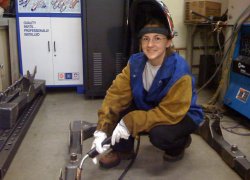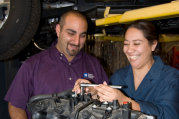Women's Success Stories
 |
Jacquelyn Etter “Just try it. You never know for sure if you’re going to like something until you try it. When I had my internship, they told me there would be some machining, and I didn’t know if I’d enjoy it, but I ended up really liking it. You never know, just give it a shot, go in with an open mind.” |
Career Quick Look
| Salary: | Approximately $20-$40 per hour | Education: |
| Years in Field: | 10 months | Las Positas College, Welding and Vacuum Technology courses Sacramento State University, B.S. Degree in Mechanical Engineering Technology |
| City/State: | Livermore, CA |
Getting Started: During high school, Jacquelyn Etter developed an interest in cars, and she wanted to take an auto shop or a welding class. “I thought cars were amazing. There are so many individual parts that have to work together correctly to make your car run. That was so interesting to me.” But she found the all-male environment around the auto shop intimidating. “There were all these guys outside standing around,” says Jacquelyn, who didn’t feel comfortable or welcome.
While she was in college, she switched majors and colleges several times. Through the process of elimination, she ended up in Mechanical Engineering Technology, the field that captured her interest most fully. During her last year in college, she held down a three-month summer internship at Lawrence Livermore National Laboratory. After graduation, she spent a month applying for jobs, hoping to get into the field of alternative energy. When she received a job offer from the Lawrence Livermore National Laboratory‘s nuclear materials testing program, she took it even though this position didn’t match her career goal.
Jacquelyn thought there was a chance she could be transferred to the National Ignition Facility, which did happen after just six months. The National Ignition Facility at the Lawrence Livermore National Laboratory is involved with experimental, ground-breaking work on using highly concentrated lasers to create energy. She is excited that these experiments may eventually be able to generate energy without using fossil fuels such as coal and oil.
Education: It took Jacquelyn a while to settle on her major in Mechanical Engineering Technology. She started college at Fresno State, and at that point didn’t declare a major. She then transferred to Humboldt State because she wanted to major in Environmental Resource Engineering, but because she had not taken the calculus courses in high school, an engineering professor there suggested she find another major. She looked into business and industrial technology, but neither seemed to fit her. She eventually transferred to Sacramento State, where she found a great match for her interests in the Mechanical Engineering Technology program. After six and a half years, she earned a Bachelor of Science degree from that program, with a minor in Spanish.
Jacquelyn was the only woman student in her Mechanical Engineering Technology classes, but she found support from women who were enrolled in other engineering programs. She also joined the local chapter of the Society of Women Engineers, which was not only a source of support but also led to her encouraging more women to enter the engineering field.
Once she began working at Lawrence Livermore National Laboratory, her employer suggested that she take additional courses in welding and vacuum technology at Las Positas College. She began taking introductory MIG (metal inert gas) and TIG (tungsten inert gas) welding in the fall of 2007, and has continued with more welding courses and a course in vacuum technology, which has given her basic knowledge about vacuum pumps, gauges, and fittings that she needs in her work environment.
Jacquelyn has enjoyed her courses at Las Positas, which have also proved helpful on the job. She finds the teachers to be very good, especially Scott Miner, her welding instructor. “He’s always there to help during lab, and his lectures are really informative about what a welder would need to know.” She was able to use the welding skills she learned in her first assignment at Lawrence Livermore National Laboratory.
Greatest Professional Achievement: Jacquelyn’s most significant professional accomplishment involved an experiment she completed with tantalum rupture disks to see if they would be acceptable for the casting system for the Nuclear Materials Testing Program. She designed the experiment, performed it, wrote up the results in a formal report, and during the project, she teamed up with project managers, engineers, and technicians.
Barriers: Jacquelyn had not planned to major in engineering when she was in high school, so she didn’t take physics or pre-calculus. When her professor at Humboldt State heard that she had not taken these courses, he encouraged her to find another major. Instead of giving up, Jacquelyn considered this a challenge. “I thought, ‘even if he doesn’t think I can do it, I’m going to try it anyway.’” She took the pre-calculus course, and says, “I had the best math teacher on the planet. He made it so easy and it was great.” She went on to take calculus, and then transferred to Sacramento State where she entered the Mechanical Engineering Technology program.
Working with Men: At her first position at the Lawrence Livermore National Laboratory, Jacquelyn was the only woman mechanical technician, but when she transferred to the diagnostics group in the National Ignition Facility, there was one other woman working there from whom she has gotten a lot of support. She hasn’t experienced any issues because of her gender, but notes that “It’s a little different working in a group with all men, the way they interact. Other than that, I’ve pretty much gotten used to it because in college I had mostly all boys in my upper division classes.”
Advice for Women: To women considering welding or another non-traditional field, Jacquelyn says, “Just try it. You never know for sure if you’re going to like something until you try it. When I had my internship, they told me there would be some machining, and I didn’t know if I’d enjoy it, but I ended up really liking it. You never know, just give it a shot. Go in with an open mind.” She had misgivings about welding as well, but found she loves it. “It’s really a detailed oriented thing, and it has to come out looking nice, so it has an artistic element to it, but it’s also concrete, useable, and functional.”
Jacquelyn encourages high school students who are at all interested in engineering and technology to take math and science classes in high school. “One regret I had was not taking any physics. Definitely take as many science and math classes as you can in high school. You can learn things easier when you’re younger,” she says. “Physics didn’t come easy for me.” She also wishes she had taken auto shop, welding, and calculus.
“I was intimidated in high school,” says Jacquelyn about the all-boy classes. “So if you want to take a class and there are no other girls, find a buddy to take the class with you.”
Typical Workday/Environment: When Jacquelyn first came to the Lawrence Livermore National Laboratory, she designed parts for the Nuclear Materials Testing Program using computer-aided drafting (CAD), machined the parts, and assembled vacuum components. She was then transferred to the National Ignition Facility at the Lab where she participates in a project which will focus 192 giant laser beams on a very small target filled with hydrogen fuel in an attempt to fuse, or ignite, the hydrogen atoms’ nuclei. Scientists hope to finally achieve self-sustaining nuclear fusion and energy gain in the laboratory. The project is sponsored by the U.S. Department of Energy's National Nuclear Security Administration.
The National Ignition Facility has many small teams working on aspects of the project. Jacquelyn first worked for a time in target diagnostics, where she designed, machined and assembled optical components. She was recently moved to the final optics assembly group. There, she is involved with multiple interim experiments and processes that help scientists understand and prepare for the final ignition, expected in 2009, which will create something equivalent to the process inside a small star or nuclear weapon. She works inside a ten-story building on a shop floor which is a special bay for the target chamber, a gigantic sphere which holds the tiny target within a clean environment.
She spends part of her time at a computer, operating these systems and doing functional checks following procedures, but she might also be working hands-on, installing these systems. She often works on the Utility Distribution Panel (UDP), which contains valves, pressure switches, and vacuum lines. Forty-eight final optics assemblies have to be installed and functioning in less than one year. Jacquelyn attaches gauges onto the panel, checks the system for leaks, and follows procedures for the installation and operational qualification for the UDP.
In addition to computer work and hands-on assembly work, she sometimes has to climb onto the sphere using a ladder, scaffolding, aerial platform, fall protection, or scissor lift. Safety is emphasized, and workers wear hard hats, safety shoes, and safety glasses. Each day before beginning work they must attend a safety meeting with their immediate work group to obtain a work permit, to ensure that the many projects going on at one time do not conflict. The work environment is very clean. The dress code is casual – jeans and t-shirts are acceptable.
Career Ladder: The salary range for someone starting in a mechanical technologist position at the Lab is approximately $20/hr to $40/hr. Multiple job series are available at different levels. Jacquelyn hopes to move to a different series, from the technician position where she is now to an engineering associate position, where she could also become a supervisor. Since this is a government job, benefits are quite generous and include medical, dental, and retirement.
Professional Associations: Jacquelyn is a member of the Society of Women Engineers, and hopes to become more actively involved with the organization again soon.
Hobbies: Jacquelyn spends some of her free time working on her friend’s “muscle car,” a 1970 Dodge Challenger. She loves the outdoors, and also enjoys mountain biking and riding a motorcycle. Recently, she rode with her female co-worker in an autocross race, which she plans to explore more fully. Jacquelyn also plays the piano and enjoys music.
 Copyright 2010 National Institute for Women in Trades, Technology & Science | http://www.iwitts.com |


